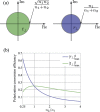Fundamental limits of ultrathin metasurfaces
- PMID: 28262739
- PMCID: PMC5338019
- DOI: 10.1038/srep43722
Fundamental limits of ultrathin metasurfaces
Abstract
We present a set of universal relations which relate the local transmission, reflection, and polarization conversion coefficients of a general class of non-magnetic passive ultrathin metasurfaces. We show that these relations are a result of equal forward and backward scattering by single layer ultrathin metasurfaces, and they lead to confinement of the transmission, reflection, and polarization conversion coefficients to limited regions of the complex plane. Using these relations, we investigate the effect of the presence of a substrate, and show that the maximum polarization conversion efficiency for a transmissive metasurface decreases as the refractive index contrast between the substrate and cladding layer increases. Furthermore, we demonstrate that a single layer reflective metasurface can achieve full 2π phase shift coverage without altering the polarization if it is illuminated from the higher refractive index material. We also discuss two approaches for achieving asymmetric scattering from metasurfaces, and realizing metasurfaces which overcome the performance limitations of single layer ultrathin metasurfaces.
Conflict of interest statement
The authors declare no competing financial interests.
Figures



References
Publication types
LinkOut - more resources
Full Text Sources
Other Literature Sources

